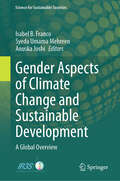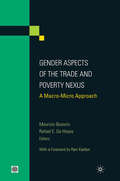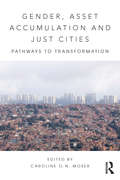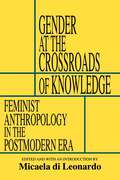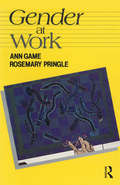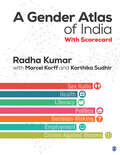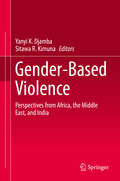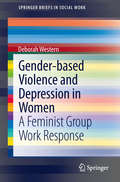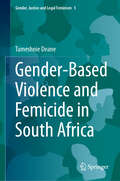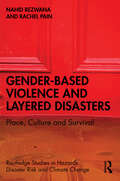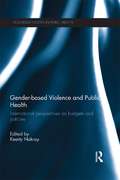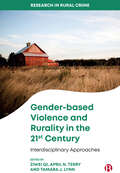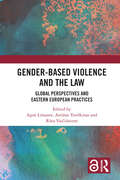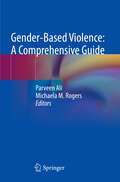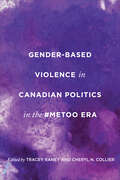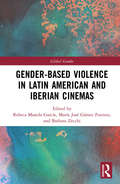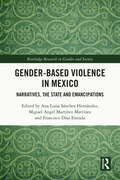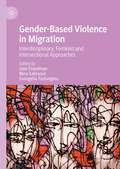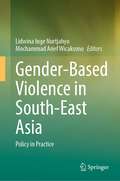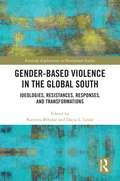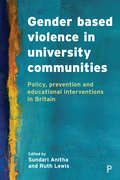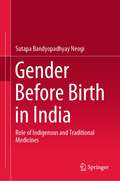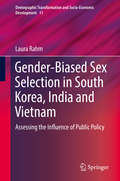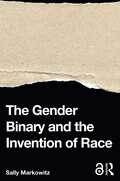- Table View
- List View
Gender Aspects of Climate Change and Sustainable Development: A Global Overview (Science for Sustainable Societies)
by Isabel B. Franco Syeda Umama Mehreen Anuska JoshiThis book addresses how sustainability discourse and advocacy can translate to impactful policies especially when bridging the divide between sustainability, climate change and gender. The book explores various areas, such as conservation, climate action, sustainable fashion, and corporate sustainability, and defines the existing sustainability gaps in the selected cases (country/sector/region). It highlights the value of sustainability science and climate change on innovative approaches to research, education, capacity-building, and practice to transform rhetoric into impact sustainability while encompassing cases from various industries, sectors, and geographical contexts. While emphasizing SDG 5, the book chapters also show the transboundary implications of gender equality and inclusivity to other sustainable development and climate change goals and targets. The contributions are exemplary in highlighting the relation of gender inclusivity in strengthening efforts to protect andsafeguard the world’s cultural and natural heritage and making cities and human settlements inclusive and safe (Goal 11), protecting, restoring, and promoting sustainable management of terrestrial ecosystems and reverse land degradation (Goal 15), ensuring access to affordable, reliable, sustainable and modern energy for all (Goal 7), promoting sustainable and inclusive economic growth with productive and decent employment for all (Goal 8), promoting inclusive and sustainable industrialization (Goal 9), adopt policies to reduce inequalities (Goal 10), ensure sustainable consumption and production pattern (Goal 12), addressing climate change impacts and building resilience (Goal 13), and ensuring availability and sustainable management of water and sanitation for all (Goal 6).
Gender Aspects of the Trade and Poverty Nexus
by Rafael E. De Hoyos Maurizio Bussolo Ravi KanburTrade liberalization can create economic opportunities for poor people. But are these opportunities available to men and women equally? Do the gender disparities in access to education, health, credit, and other resources limit the gains from trade and the potential benefits to poor women? This volume introduces the gender dimension into empirical analyses of the links between trade and poverty, which can improve policy making. The collection of chapters in this book is close to an ideal macro-micro evaluation technique that explicitly assesses the importance of gender in determining the poverty effects of trade shocks. Part I, relying on ex ante simulation approaches, focuses on the macroeconomic links between trade and gender, where labor market structure and its functioning play a key role. Part II concentrates on micro models of households and attempts to identify the ex post effects of trade shocks on household income levels and consumption choices. It also addresses questions about possible changes in inequality within households due to improved economic opportunities for women. 'Gender Aspects of the Trade and Poverty Nexus' will be invaluable to policy makers, development practitioners and researchers, journalists, and students.
Gender, Asset Accumulation and Just Cities: Pathways to transformation
by Caroline O.N. MoserWith more than half the world’s population now living in urban areas, urbanisation is undoubtedly one of the most important phenomena of the 21st century. However, despite increasing recognition of the critical relationship between economic and social development in cities, gender issues are often overlooked in understanding the complexities of current urbanisation processes. This book seeks to rectify this neglect. Gender, Asset Accumulation and Just Cities explores the contribution that a focus on the gendered nature of asset accumulation brings to the goal of achieving just, more equitable cities. To date neither the academic debates nor the formulated policy and practice on just cities has included a focus on gender-based inequalities, discriminations, or opportunities. From a gender perspective, a separate discourse exists, closely associated with gender justice, particularly in relation to urban rights and democracy. Neither, however, has addressed the implications for women’s accumulation of assets and associated empowerment for transformational pathways to just cities. In this book, contributors specifically focus on gender and just cities from a wide range of gendered perspectives that include households, housing, land, gender-based violence, transport, climate, and disasters.
Gender at the Crossroads of Knowledge: Feminist Anthropology in the Postmodern Era
by Micaela Di LeonardoGender at the Crossroads of Knowledge brings feminist anthropology up to date, highlighting the theoretical sophistication that characterizes recent research. Twelve essays by outstanding scholars, written with the volume's concerns specifically in mind, range across the broadest anthropological terrain, assessing and contributing to feminist work on biological anthropology, primate studies, global economy, new reproductive technologies, ethno-linguistics, race and gender, and more. The editor's introduction not only sets two decades of feminist anthropological work in the multiple contexts of changes in anthropological theory and practice, political and economic developments, and larger intellectual shifts, but also lays out the central insights feminist anthropology has to offer us in the postmodern era. The profound issues raised by the authors resonate with the basic interests of any discipline concerned with gender, that is, all of the social sciences and humanities.
Gender at Work
by Rosemary Pringle Ann GameThree themes are drawn together in this book: gender and sexuality, the organisation of work, and the impact of technological change. Their inter-relationship is explored in six area studies: manufacturing, banking, retailing, computing, nursing and housework.Gender at Work presents an account of how each area has changed since the Second World War; sets out ways in which the notion of what constitutes 'proper' work for men and women changes with new work processes; and analyses the prospects for, and limits of, sexual 'equality' in the workplace.Based on the first-hand observations of workers, reflecting on their work experience, this book allows workers to speak for themselves: they reveal the centrality of gender to the way capitalism is organised.'A notable contribution, both to feminist and labour studies in Australia and further afield. Every woman, whether at home or in the paid workforce, should read this book. It will help her assess exactly what she is - and should be - worth to the community, and how she can help to ensure her true evaluation.' - Newcastle Herald'A very readable book which makes a major theoretical and descriptive contribution to the analysis of gender in Australian Society.' - Journal of Industrial Relations'A convincing demonstration of the central place of gender in the work relationships between men and women. The insights it provides, into the underlying causes of the sex division of tasks and the way in which new jobs in any individual setting quickly become sex-typed, are important for any manager of a mixed workplace.' - Practising Manager
A Gender Atlas of India: With Scorecard
by Radha Kumar Marcel Korff Karthika SudhirA Gender Atlas of India is a seminal body of work which comprehensively maps and grades India’s performance from 2001 to 2016 on issues of concern for women. Taking into account 8 overall indicators and 28 sub-indicators, it looks at how India is performing on various aspects, including sex ratio, women’s education, employment, health, political participation and representation; and prevention of crimes against women. Unlike previous attempts, this book examines the change in India’s performance over a 15-year period, compares the situation of women in India to that in its neighborhood and internationally, and rates each Indian state and union territory individually. The findings in this book are both provocative and incentivizing for policymakers—they show that where the central and state governments share concerns India’s performance on gender has improved, but where they diverge women’s condition has deteriorated even further. With data from a range of government and independent institutions, the Census of India, Family Health Surveys, UN Statistics, World Bank data, and NGO and industry surveys, this book is an essential reference for policymakers, government departments, libraries, and individuals.
Gender-Based Violence
by Yanyi K. Djamba Sitawa R. KimunaThis book offers new perspectives on gender-based violence in three regions where the subject has been taboo in everyday discourse often due to patriarchal cultural norms that limit women's autonomy. The contributions to this book provide rare insight into not only the levels and the socio-demographic determinants of domestic violence, but topics ranging from men's attitudes toward wife beating; domestic violence-related adolescent deaths, and women's health problems due to sexual and physical abuse. With a comprehensive introduction that provides a comparative international research framework for discussing gender-based violence in these three unique regions, this volume provides a key basis for understanding gender-based violence on a more global level. Part I, on Africa, covers men's attitudes towards domestic violence, the impact of poverty and fertility, the association between adolescent deaths and domestic violence, and the link between domestic abuse and HIV. Part II, on the Middle East, covers the importance of consanguinity on domestic violence in Egypt and Jordan, the effects of physical abuse on reproductive health, and the link between political unrests and women's experience and attitudes towards domestic violence. Part III, on India, shows how sexual abuse puts women at risk of reproductive tract infections and sexually transmitted infections, as well as the role of gender norms in wife abuse and the role of youth aggressive behavior in nonconsensual sex. With such a deep and broad coverage of factors of intimate partner abuse, this book serves as a reference document for researchers, decision-makers, and organizations that are searching for ways to reduce gender-based domestic violence. This book is of interest for researchers in Criminology and Criminal Justice, as well as Sociology, Social Work, Public Health and Human Rights.
Gender-based Violence and Depression in Women
by Deborah WesternSocial workers, in whatever capacity they work, can expect to come into contact with women who have experienced/are experiencing violence and with women who are experiencing depression. Therefore, a range of social work supports and interventions are required in order to meet the needs of diverse women and assist them in their recovery. One of these methods is group work where women can share their experiences, learn from each other, reflect on their learnings and identify and achieve changes in their circumstances. This book is based on original research by the author that sought to understand depression in women from a feminist and gender-informed perspective, develop a feminist-based group work response, and highlight the activities of consciousness-raising and resistance as methods for women to achieve change in their lives and in their selves. An innovative and creative group work program, the Women's Journaling Group Program, was developed from this research and provides a new method of working with women who have experienced/are experiencing violence and mild-moderate depression. The Women's Journaling Group Program is research-informed, theoretically-grounded, practice-based and feminist and gender-focused. This book, and the program model within it, is an important contribution to the field of critical feminist social work practice.
Gender-Based Violence and Femicide in South Africa (Gender, Justice and Legal Feminism #5)
by Tameshnie DeaneThis book presents new perspectives on gender-based violence (GBV) in South Africa. It argues that violence against women is a manifestation of unequal gender relations and harmful manifestations of hegemonic masculinity, which are governed by patriarchal beliefs, institutions and systems. It includes chapters on quantitative research that assess not only the levels and determinants of violence against women but also men’s attitudes towards gender-based violence, perceptions of violence, the legislative frameworks governing violence against women in South Africa, and the current cases and jurisprudence relating to this scourge. In spite of its focus on South Africa, the book also provides insights for comparative scholars exploring the value of different constitutional articulations of human rights and how they support (or fail to support) efforts to combat violence against women. By assessing recent incidents and responses to gender-based violence, the book provides a view of not only the societal but also jurisprudential opportunities and pitfalls in this area that may be applicable elsewhere. Gender equality and, central to this, the right of women to live lives free of violence, is a precondition for full democratic participation and is a universal goal. Accordingly, the South African experience contributes to a wider understanding of the possibilities and limitations of societal and legal reform in challenging the ubiquity of violence against women. The book is aimed at researchers, practitioners, students, professionals and advocates in the field of gender-based violence.
Gender-Based Violence and Layered Disasters: Place, Culture and Survival (Routledge Studies in Hazards, Disaster Risk and Climate Change)
by Nahid Rezwana Rachel PainThis book investigates the widespread and persistent relationship between disasters and gender-based violence, drawing on new research with victim-survivors to show how the two forms of harm constitute ‘layered disasters’ in particular places, intensifying and reproducing one another. The evidence is now overwhelming that disasters and gender-based violence are closely connected, not just in moments of crisis but in the years that follow as the social, economic and environmental impacts of disasters play out. This book addresses two key gaps in research. First, it examines what causes the relationship between disasters and gender-based violence to be so widespread and so enduring. Second, it highlights victim-survivors’ own accounts of gender-based violence and disasters. It does so by presenting findings from original research on cyclones and flooding in Bangladesh and the UK and a review of global evidence on the Covid-19 pandemic. Drawing on feminist theories, it conceptualises the coincidence of gender-based violence, disasters and other aggravating factors in particular places as ‘layered disasters.’ Taking an intersectional approach that emphasises the connections between culture, place, patriarchy, racism, poverty, settler-colonialism, environmental degradation and climate change, the authors show the significance of gender-based violence in creating vulnerability to future disasters. Forefronting victim-survivors’ experiences and understandings, the book explores the important role of trauma, and how those affected go about the process of survival and recovery. Understanding disasters as layered casts light on why tackling gender-based violence must be a key priority in disaster planning, management and recovery. The book concludes by exploring critiques of existing formal responses, which often ignore or underplay gender-based violence. The book will be of interest to all those interested in understanding the causes and impacts of disasters, as well as scholars and researchers of gender and gender-based violence.
Gender-based Violence and Public Health: International perspectives on budgets and policies
by Keerty NakrayGender-based violence is a multi-faceted public health problem with numerous consequences for an individual’s physical and mental health and wellbeing. This collection develops a comprehensive public health approach for working with gender-based violence, paying specific attention to international budgets, policies and practice and drawing on a wide selection of empirical studies. Divided into two parts, the text looks at how public health budgets and policies can be used to influence a range of risk factors and outcomes, and then outlines a theoretical and conceptual framework. The second section draws on empirical studies to illustrate ways of managing the risks and impacts of, and responses to, the problem. It concludes by summarising those risk factors that can be effectively addressed through appropriately budgeted public health programmes globally. Highlighting ways of bolstering protective and resilience factors and identifying early interventions, it demonstrates the importance of inter-agency interventions through coordinated effort from a wide range of sectors including social services, education, religious organisations, judiciary, police, media and business. This inter-disciplinary volume will interest students and researchers working on gender-based violence, gender budgeting and public health policy from a range of backgrounds, including public health, sociology, social work, public policy, gender studies, development studies and economics.
Gender-based Violence and Rurality in the 21st Century: Interdisciplinary Approaches
by Ziwei Qi, April N. Terry, Tamara J. Lynn and Walter S. DeKeseredyGender-based violence (GBV) can take many forms and have detrimental effects across generations and cultures. The triangulation of GBV, rurality and rural culture is a challenging and essential topic and this edited collection provides an innovative analysis of GBV in rural communities. Focusing on under-studied and/or oppressed groups such as immigrants and LGBTQIA+ people, the book explores new theories on patterns of violence. Giving insights into GBV education and prevention, the text introduces community justice and victim advocacy approaches to tackling issues of GBV in rural areas. From policy review into actionable change, the editors examine best practices to positively affect the lives of survivors.
Gender-Based Violence and the Law: Global Perspectives and Eastern European Practices
by Agnė Limantė Artūras Tereškinas Rūta VaičiūnienėThis book presents a novel and insightful examination of gender-based violence, inviting readers to consider this topic from various perspectives. It encompasses various conceptual discussions and international regulations and trends, while concurrently emphasising the legal regulations and practices of select Central and Eastern European countries. Significantly underrepresented in legal scholarship, this region has been overlooked and subject to limited comprehensive analyses. The authors address different aspects of gender-based violence, also covering some areas that have received little attention in academic literature, such as gender-based violence in academia and cyberstalking. Furthermore, the book incorporates recent empirical studies, thereby endowing readers with valuable insights into the specific challenges encountered in the region. By contributing to current research on gender-based violence in Europe, this publication is an invaluable resource for researchers, students, policymakers, and general readers interested in gender-based violence and the fight against it in the Central and Eastern European region.
Gender-Based Violence and the Law: Global Perspectives and Eastern European Practices
by Agnė Limantė Artūras Tereškinas Rūta VaičiūnienėThis book presents a novel and insightful examination of gender-based violence, inviting readers to consider this topic from various perspectives. It encompasses various conceptual discussions and international regulations and trends, while concurrently emphasising the legal regulations and practices of select Central and Eastern European countries. Significantly underrepresented in legal scholarship, this region has been overlooked and subject to limited comprehensive analyses. The authors address different aspects of gender-based violence, also covering some areas that have received little attention in academic literature, such as gender-based violence in academia and cyberstalking. Furthermore, the book incorporates recent empirical studies, thereby endowing readers with valuable insights into the specific challenges encountered in the region. By contributing to current research on gender-based violence in Europe, this publication is an invaluable resource for researchers, students, policymakers, and general readers interested in gender-based violence and the fight against it in the Central and Eastern European region.
Gender-Based Violence: A Comprehensive Guide
by Parveen Ali Michaela M. RogersThis book provides comprehensive information about various types of gender-based violence (GBV) and abuse. GBV is a major public health and social problem that affects people, mostly women and girls, in every community, culture, and country. GBV refers to the violence or a pattern of abusive behaviours including physical aggression, sexual coercion, psychological abuse and controlling behaviours resulting in physical, sexual or psychological harm. It is associated with severe physical and psychological consequences, and can result in death. . GBV can take many forms including female foeticide, infanticide, female genital mutilation, child marriage, grooming, trafficking, forced marriage, dowry- related abuse, honour-based violence, rape, sexual assault, stalking, harassment, street violence, abuse against older people, domestic violence, and intimate partner violence. It can take place in public, private and virtual settings, and within the context of intimate, familial, community and institutional relationships. While all these forms affect girls and women more, boys and men can also be exposed of various forms of violence including child abuse, sexual abuse, wartime violence, corporal punishment to name a few. This book takes a unique approach and presents an overview of gender-based violence and related practices throughout the world. The book is written in a user friendly manner in order to be accessible as an introductory text to a wide range of readers including students, practitioners and researchers. Edited by a public health academic and a social worker, with contributions representing a wide range of disciplines, the book will appeal to many professions including nurses, midwives, social care and social work practitioners, police, teachers, psychologists, and sociologists.
Gender-Based Violence in Canadian Politics in the #MeToo Era
by Tracey Raney Cheryl N. CollierGender-based violence in politics is a significant and growing problem that threatens the democratic process in Canada. Despite its prevalence, little academic research has been conducted on this topic to date. Gender-Based Violence in Canadian Politics in the #MeToo Era raises awareness of and presents new innovative research on this timely and pressing public issue. Here, leading experts from across Canada uncover critical new insights and identify potential solutions that would help address gender-based violence in politics, improve gender equality, and strengthen Canadian democracy. Using an intersectional lens, chapters range in their approaches; offer new concepts and measures of gender-based violence in online political spaces, political media coverage and cartoons, campaigns, municipal politics, and legislatures; and explore Indigenous ways of knowing about gender-based violence in Canadian politics. Additionally, the volume presents recommendations for decision-makers, policymakers, anti-violence advocates, and the academic community on how to best address the problem of gender-based violence in the political sphere.
Gender-Based Violence in Latin American and Iberian Cinemas (Global Gender)
by García Rebeca Maseda / Gámez Fuentes María José Barbara ZecchiGender-Based Violence in Latin American and Iberian Cinemas rethinks the intersection between violence and its gendered representation. This is a groundbreaking contribution to the international debate on the cinematic construction of gender-based violence. With essays from diverse cultural backgrounds and institutions, this collection analyzes a wide range of films across Latin America and the Iberian Peninsula. The volume makes use of varied perspectives including feminist, postcolonial, and queer theory to consider such issues as the visual configuration of power and inequality, the objectification and the invisibilization of women’s and LGBTQ subjects’ resistance, the role of female film-makers in transforming hegemonic accounts of violence, and the subversion of common tropes of gendered violence. This will be of significance for students and scholars in Latin American and Iberian studies, as well as in film studies, cultural studies, and gender and queer studies.
Gender-Based Violence in Mexico: Narratives, the State and Emancipations (Routledge Research in Gender and Society)
by Martínez Martínez, Miguel Angel Francisco Díaz EstradaThis book examines the roots of systemic aggression against women in contemporary Mexico, and the connection between social practices and the institutional permissiveness of the Mexican State with regard to gendered violence. Since the democratic transition at the end of the 1990s, Mexico has registered an increase in the intensity and types of violence that have made life in some regions almost unsustainable. The chapters in this volume consider that capitalism, colonialism and patriarchy are interrelated processes that employ the technologies of gender and race as a continuation of the symbolic hegemony that treats feminized and racialized bodies as disposable. Against this background, it becomes necessary to understand from different dimensions the systemic violence against women as well as the processes of articulation between social practices and the permissiveness of the State in the face of aggression. Gender-Based Violence in Mexico mobilizes a dialogue between writings, fields of knowledge, causes and situations as essential tools for the struggle against gender violence. As a situated work that underlines the systematic roots of the violence that keeps women in subaltern positions, the text seeks an insurrection, an uprising of the bodies that invite naming the abject, peripheral and unseen populations of the project of globalized life, woven by the obsession of success and prestige. It presents a counter-conclusion in the manner of a beginning in the desire to elaborate counter-political and counter-pedagogical strategies of non-coercive experiences, where questions and debates are not a sign of belligerence but of vitality and care for the body-territories. Gender-Based Violence in Mexico will appeal to scholars of sociology, criminology, gender and Latin American studies with interests in gendered violence and injustice.
Gender-Based Violence in Migration: Interdisciplinary, Feminist and Intersectional Approaches
by Jane Freedman Nina Sahraoui Evangelia TastsoglouWith contributions from a diverse array of international scholars, this edited volume offers a renewed understanding of gender-based violence (GBV) by examining its social and political dimensions in migration contexts. This book engages micro, meso, and macro levels of analysis by foregrounding a conceptualization of GBV that addresses both its interpersonal and structural causes. Chapters explore how GBV frameworks and migration management intersect, bringing to the forefront the specific inequalities these intersections produce for migrant women. Drawing upon several disciplines, the authors engage in co-writing a critical engagement which proposes an original understanding of how the concepts of intersectionality, vulnerability and precarity speak to each other from a feminist perspective. This volume will be of interest to scholars/researchers and policymakers in Gender Studies, Migration and Refugee Studies, Sociology, Political Science, Trauma Studies, Human Rights and Socio-Legal Studies.
Gender-Based Violence in South-East Asia: Policy in Practice
by Lidwina Inge Nurtjahyo Mochammad Arief WicaksonoThis book presents new research on gender-based violence in Southeast Asia, bringing together varied scholarly work in law, policy, and practice. It enables a greater understanding of violence against women as an international concern, highlighting particular issues that arise in the region. Against a background of international obligations to ensure women's rights through laws and policies that are geared at ending violence against women and girls, this research documents the state failures, individual shame and fear, and societal culture that collectively affects the reporting, investigation, prosecution of perpetrators, and protection of victims. The research explores differing legal mechanisms both internationally, and within nation states, relating to cases of physical and sexual violence. It recognizes the need for functioning mechanisms to ensure women can report their cases safely and be provided with protective and therapeutic services in a way that is systematic, effective, and measurable. Laws and court decisions are analyzed, crisis and safety centers are examined, and in-depth interviews are conducted with actors and NGOs with relevant roles and functions in the mechanism of cases of violence against women. The result is a comprehensive assessment of the incalculable harm it does within Southeast Asian society, and the obstacles it presents for law enforcement. The chapters uncover mechanisms with unique characteristics across Southeast Asia, providing a nuanced understanding of the cultural and social backgrounds, as well as the religious structures, that can both help and hinder suitable frameworks. It is relevant to scholars, policymakers, and practitioners in law, criminology, and gender sociology.“This is a valuable contribution towards empowering the women of South East Asia out of victimhood to valued equality, involvement in governance and leadership through the elimination of violence and discrimination and an excellent resource not just for those working in this field but for those involved in law making, the media and the people of South East Asia.”- Professor Felicity Gerry QC, Barrister at Crockett Chambers Melbourne and Libertas Chambers, London, and Professor of Legal Practice at Deakin University and Honorary Professor at Salford University.
Gender-Based Violence in the Global South: Ideologies, Resistances, Responses, and Transformations (Routledge Explorations in Development Studies)
by Dacia L. LeslieThis book amplifies the different voices and experiences of those facing gender-based violence (GBV) in the Global South. It explores the localised ways in which marginalised individuals design modes of coping with and address GBV, including cultural interpretations, and artistic and faith-based expressions.The book examines GBV triggers, prevalence, and societal impacts while referring to community, national, and regional mobilisation to deal with the phenomenon in its various manifestations, including physical, psychological, political, domestic, and public violence. It explores issues related to women’s negotiations with the patriarchal underpinnings of GBV; the role of the law and history in the perpetuation of GBV; the complementary role of culture and faith to legal protection against GBV, and access to justice for women and girls. In doing so, the book exposes understandings and expressions of GBV, as well as methodologies and indigenous initiatives to prevent it through local viable solutions. The book thus challenges the normalisation of GBV in the Global South.Providing concrete and culturally relevant suggestions for challenging ingrained models of gender understandings of violence in the Global South, this book will be of interest to academics in the fields of Development Studies, Gender Studies, Women’s Studies, Violence and Abuse Studies, Human Rights, Criminal Law, and Socio-Legal Studies.
Gender Based Violence in University Communities: Policy, Prevention and Educational Initiatives
by Sundari Anitha and Ruth LewisUntil recently, higher education in the UK has largely failed to recognise gender-based violence (GBV) on campus, but following the UK government task force set up in 2015, universities are becoming more aware of the issue. And recent cases in the media about the sexualised abuse of power in institutions such as universities, Parliament and Hollywood highlight the prevalence and damaging impact of GBV. In this book, academics and practitioners provide the first in-depth overview of research and practice in GBV in universities. They set out the international context of ideologies, politics and institutional structures that underlie responses to GBV in elsewhere in Europe, in the US, and in Australia, and consider the implications of implementing related policy and practice. Presenting examples of innovative British approaches to engagement with the issue, the book also considers UK, EU and UN legislation to give an international perspective, making it of direct use to discussions of ‘what works’ in preventing GBV.
Gender Before Birth in India: Role of Indigenous and Traditional Medicines
by Sutapa Bandyopadhyay NeogiThis book focuses on the role of the indigenous system of medicine or traditional medicines in gender selection in India. Issues such as the harmful effects of traditional practices on the health of the woman and the foetus during early pregnancy are explored in this book. It analyses the social and cultural practices and establishes linkages with modern methods of scientific investigations. It discusses how systematic exploration lends evidence of harmful traditional practices. The book is an important read for researchers, healthcare professionals and students in the field of medicine, public health and social sciences. It is an extremely valuable resource for all those engaged in research of traditional and modern systems of medicine.
Gender-Biased Sex Selection in South Korea, India and Vietnam: Assessing the Influence of Public Policy (Demographic Transformation and Socio-Economic Development #11)
by Laura RahmThis book provides an in-depth analysis of the influence of public policy on sex selection. Three Asian countries were chosen for the comparative policy analysis, namely South Korea, India and Vietnam that share in common a historical legacy of son preference, high levels of sex imbalances and active policy response to curbing the growing demographic masculinization of their nations. The research based on the data collected from field work in the three countries shows that despite the adoption of very similar anti-sex selection policies the outcomes have been markedly different for each of the three countries. These unexpected diverse outcomes are explained partly by their different historical and cultural contexts, and partly to the different social, political and economic institutions and dynamics. This monograph offers careful and detailed explanations of both within and across country diversities in policy outcomes, pointing to the importance and the limits of cross-national policy learning and adoption, and raising questions about the efficacy of international organizations’ current approaches to global policy and knowledge transfer.
The Gender Binary and the Invention of Race
by Sally MarkowitzThe Gender Binary and the Invention of Race explores a fundamental and often overlooked connection between modern European conceptions of gender and race. Starting in the eighteenth century, these conceptions have intermeshed through a racialized gender‑binary ideal for the male‑female couple that, supposedly, only Europeans embody.Through an exploration of various expressions of this racial gender-binary ideal, this book illuminates the deep connections between categories of race, sex/gender, and sexuality and the social hierarchies they support. This book also explores how the racial gender‑binary ideal has both shaped fin‑de‑siecle arguments for the respectability of male homosexuality and informed the mid‑twentieth‑century feminist analysis of Simone de Beauvoir’s The Second Sex. Finally, this book compares its approach to understanding the racegender connection to that of intersectional theorist Kimberle Crenshaw.The Gender Binary and the Invention of Race is an accessibly written book that will be of interest both to undergraduate and graduate students of Gender Studies, as well as to a general audience wishing to learn more about the relationship between the categories of race, gender, and sexuality.
